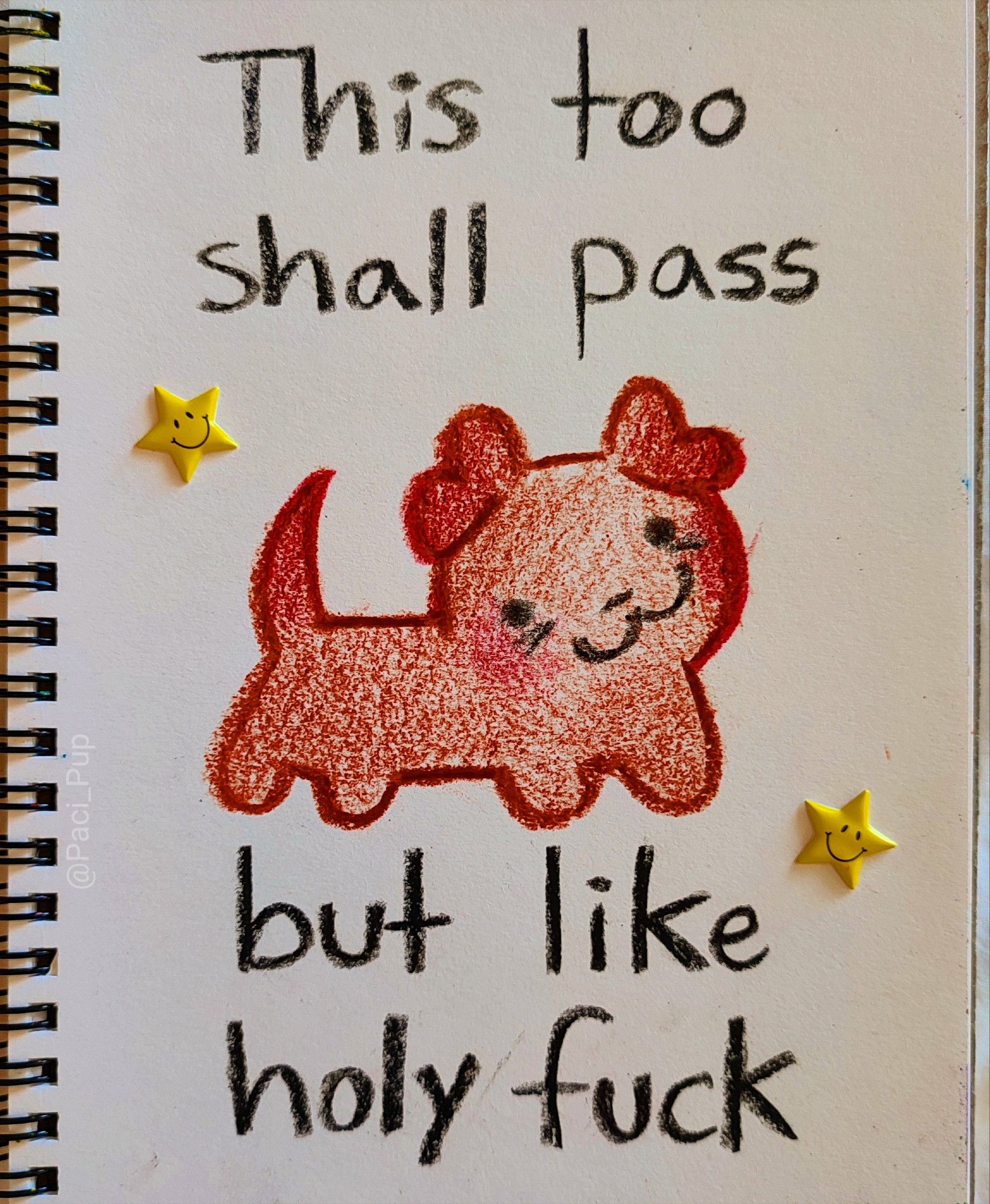- Creativity for Good
- Posts
- 💜(9/19) the creativity for good friday five
💜(9/19) the creativity for good friday five
this week’s highlights on creating for good
So! It sure has…been a week, huh?
But none of you are here for the recap of everything going on in the hellscape that is The News. This is the “Creativity for Good” newsletter after all, not the “Creativity for Screaming into the Void” newsletter.
(Though if that exists, please for the love of god send me a link, because I’d read the hell out of it.)
Two of my go-to teachers in moments like this are Kelly Hayes and Mariame Kaba, co-authors of Let This Radicalize You: Organizing and the Revolution of Reciprocal Care — a book I consider to be a must-read in this shitshow of a time. One of their most-quoted mantras is the belief that hope is a discipline, and (maybe even more importantly), that hope and optimism are two very different things. In an interview she gave back in 2020, Kaba said,
That speaks to me as a philosophy of living, that hope is a discipline and that we have to practice it every single day. Because in the world which we live in, it’s easy to feel a sense of hopelessness, that everything is all bad all the time, that there is nothing going to change ever, that people are evil and bad at the bottom. It feels sometimes that it’s being proven in various, different ways, so I get that, so I really get that. I understand why people feel that way. I just choose differently. I choose to think a different way and I choose to act in a different way. I choose to trust people until they prove themselves untrustworthy.
Organizers like Hayes and Kaba understand that while optimism is a belief in a positive future, hope is the motivational energy that strives towards action. Where optimism says, “everything will be okay,” hope says, “we might not know if everything will be okay, but we do know that we can do something, every day, to make that better future a reality.
Creativity for Good is grounded in hope, not optimism. I don’t write to you to tell you that this moment will pass, that we will find ourselves in a “new normal” built on a foundation of liberation, safety, community, and joy, that everything will, as they say, be okay. I’d love to say that, genuinely I would, but I don’t think I can — at least, not with full-hearted belief. But what I do do, every time I sit down to work on this newsletter (and look, here I am, two weeks in a row, just like I promised!), is focus on hope. And, more importantly, the ways that creativity keeps us hopeful, keeps us connected, and keeps us moving towards making things better.
One action, one moment, one day at a time.
your friday five!
this week’s highlights on creating for good
Science Must Go On: How Courageous Scientists Are Meeting the Moment (Gretchen Goldman for The Equation)
Scientific institutions are under fairly horrendous attack right now, from the CDC to the National Science Foundation to the Census Scientific Advisory Committee. As a mentally ill disabled person, this is more than a little terrifying, and I’m luckier than many to be living in a blue state that just formed its own science-based health collective. But seeing scientists across multiple disciplines band together to give an effective fuck-you to administrative shutdowns, data-silencing, and flat-out suppression of scientific recommendations is inspiring.
“The scientific community now has the chance to apply this strategy at scale,” Goldman wrote. “Because the dismantling of the federal scientific advice apparatus has been so severe and wide-ranging, there are ample opportunities for the scientific community to step up — and we must.”On Purple Prose (Alix E. Harrow for The Written Word)
“Oh, come on, Shelly,” I hear you saying, “how is self-indulgent, overly-prosey writing supposed to help the revolution?” Alix lays out the answer to this:
“i worry that the preference for clean, frictionless, unornamented prose is symptomatic of our increasingly consumer-brained approach to art, where the “best” art is whatever goes down the easiest. i worry that our attention spans are so thoroughly deep-fried that we no longer have the patience for long sentences or semi-colons. […] a rejection of complex language is a rejection of complexity itself. if we aren’t willing to engage with the ambiguous or confusing, the challenging or messy or idiosyncratic or subtle or superfluously, impractically beautiful–then we are left with the short and simple, the easy and efficient. and that is, frankly, kind of dangerous.”
I will be real with you: I adore purple prose. I love an aside, a sentence within a sentence, a bonus thought. I love an em dash (fuck you, AI), a parenthetical extra, a semicolon, a generous application of the Oxford comma. There is, of course, something to be said for occasionally Hemingway-ing our way through the work, but to lean into prose in a thousand shades of purple is, almost always, inherently joyful work. It’s finding the delight and wonder hiding out in the corners of every paragraph. And that, my friends, is some anti-fascist shit.“We Are Not Going Back to the Shadows”: Staten Island’s Mexican Parade Marches On (Rommel H. Ojeda for Documented)
SPEAKING OF ANTI-FASCIST SHIT, let’s talk about visible acts of resistance. ICE is fucking terrifying right now, and many immigrant communities are (entirely understandably) avoiding major demonstrations or gatherings out of fear. (This recent video of Illinois state senator Karina Villa walking the streets in Chicago — in heels! — telling her constituents to stay inside and stay safe still makes me shiver.)
But community, as I’ve written before, is the antidote to despair. Parades like this one in Staten Island (where 21% of the population is Hispanic) are a clear declaration that actually, pride won’t be silenced, communities won’t hide themselves away, and that solidarity will always be stronger than hate.How To Raise a Reader in an Age of Digital Distraction (Jessica Ewing for Literary Hub)
I was a reader as a kid. I always had a book in my backpack in addition to whatever I was reading for school. My one and only detention came from trying to get away with reading one more chapter of The Enchanted Forest Chronicles under my desk in fifth grade math.
As a parent, it’s been a fucking delight to watch my kids learn to love books. My five-year-old is constantly reading to herself, and when we read to her, she’s obsessed with fantasy chapter books: Redwall, The Chronicles of Narnia, The Enchanted Forest Chronicles (an inter-generational fave, shout-out to Princess Cimorene — my girl indoctrinating the next generation of fuck-you feminists!), The Book of Three, A Wrinkle in Time.
But at the same time, she’s constantly angling for more screen time, and that’s a push-and-pull struggle…One I’m for sure not helping with because of my own totally obvious addiction to my phone. As far as she’s concerned, it doesn’t matter if I’m using it to read an ebook — she sees me looking at a screen, and she gets grumpy and jealous.
Ewing’s take on this is one of the more helpful approaches I’ve seen in a long time:
“The children who are thriving as readers in 2025 aren’t growing up in some idealized, screen-free bubble. They’re learning to navigate a complex media landscape with intention and purpose. […] But here’s what I find most encouraging: the human brain remains remarkably plastic, especially in childhood. Every day presents new opportunities to build these crucial circuits. Every bedtime story, every conversation about a book, every moment of focused attention is rewiring our children’s minds for the better.” (emphasis mine)
I’m not saying that every intentional bedtime ritual is a tiny act toward revolution. But I’m not not saying it, either. And as far as ways to cultivate hope — well, if my five-year-old can do it, why can’t we?The Winning Images in the Astronomy Photographer of the Year Contest Have Been Announced — See Our Favorites (Stephanie Friedman for Nice News Daily)
An evergreen reminder: The universe is so much bigger than this moment. It’s reassuring, I think, to remember that there is a vastness around us that goes on, beautiful and endless and enduring, no matter what takes place here on Earth. Whatever happens, the universe goes on. And in some small way, because nothing can ever truly be destroyed, we — in all our creativity, in all our actions, in all our hope — go with it.
However you’re doing, whatever you’re doing: Hang in there. Keep going. Keep hoping.
See you next week!
💜Shelly

